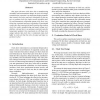Free Online Productivity Tools
i2Speak
i2Symbol
i2OCR
iTex2Img
iWeb2Print
iWeb2Shot
i2Type
iPdf2Split
iPdf2Merge
i2Bopomofo
i2Arabic
i2Style
i2Image
i2PDF
iLatex2Rtf
Sci2ools
ISQED
2005
IEEE
2005
IEEE
Statistical Analysis of Clock Skew Variation in H-Tree Structure
This paper discusses clock skew due to manufacturing variability and environmental change. In clock tree design, transition time constraint is an important design parameter that controls clock skew and power dissipation. In this paper, we evaluate clock skew under several variability models, and demonstrate relationship among clock skew, transition time constraint and power dissipation. Experimental results show that constraint of small transition time reduces clock skew under manufacturing and supply voltage variabilities, whereas there is an optimum constraint value for temperature gradient. Our experiments in a 0.18 m technology indicate that clock skew is minimized when clock buffer is sized such that the ratio of output and input capacitance is four.
| Added | 25 Jun 2010 |
| Updated | 25 Jun 2010 |
| Type | Conference |
| Year | 2005 |
| Where | ISQED |
| Authors | Masanori Hashimoto, Tomonori Yamamoto, Hidetoshi Onodera |
Comments (0)

